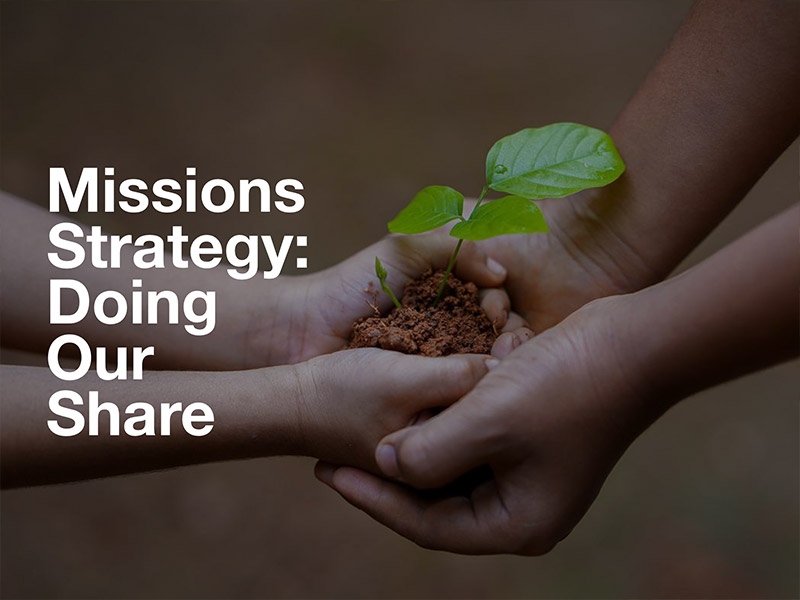Missions Strategies: Part 3 – Doing Our Share

Missions Partnerships are one of the best vehicles a church can use to engage fully in missions. A healthy partnership will contain five elements, and the third element is Doing Our Share. Even though financial support is the first thing many people’s mind jumps to when they consider missions partnership, we’ve intentionally placed it third behind relationship and prayer because we think it shouldn’t proceed those two things. But while this may seem like a straightforward strategy, we often miss out on engagement with the whole church because we can think too narrowly. The ideas below may be useful in helping you and your team think through how to develop an effective strategy to financially support your International Worker (IW) partner.
- Give to the Worker, Give to the Whole. While it’s true that IWs in the C&MA are responsible to raise some of their support, giving to the Great Commission Fund (GCF) is still very much needed. For starters, the vast majority of the total cost to keep an IW on the field (75%) still comes from the general GCF and not from their dedicated support. Second, if existing IWs were the only recipients of giving, it would be more difficult to explore new ministry opportunities where no workers currently serve. Therefore, as you consider your strategy, make sure to engage with your partner and the GCF at large.
- Budgeted and Designated. Often a missions team will ask, “Should we budget our partner support, or just take up offerings?” The best answer is, try to do both. If you have committed to supporting your partner at a specific amount, you may want to work some or all of that into your general church budget. This telegraphs the importance of your commitment and sets an example for church members to consider when they approach giving. However, by failing to call people to give to missions above and beyond a tithe is a missed opportunity for obedience, sacrifice, and blessing.
- Celebrate. Sometimes our reluctance to talk about money in church is due to the fact that we only talk about it when we’re asking for it. By recognizing and celebrating giving (at times without even a direct ask) we help create a culture where money isn’t taboo, but is simply a part of the reality of completing the work God has given to us.
- Break it Down and Make it Real. As you think about engaging the different demographics in the church, consider using bite-sized goals that connect to tangible realities. For example, I know of churches who used small groups to purchase books for classrooms or children’s ministries that raised money for all kinds of special projects.
- Have at Least 6 Ways to Give. You may think of more, but here are what I would consider the minimum modes of giving. If you miss out on one of these, you’re likely missing out on an entire demographic of your church:
- In person. This is a gimme, but accepting cash and checks at a gathering is still important.
- By mail. Most banks offer free bill pay with the ability to automate a check to be mailed directly to the church. Consider offering assistance in helping people set this up if needed.
- Digitally. Notice I didn’t say “online”. An online portal on your website is a must, but consider the ability to receive payments via Apple Pay, Venmo, and Google Pay. These are simply a fact of life for anyone under 25 years of age.
- Non-traditional Gifts. Nearly 80% of our wealth is non-cash: investments, property, business interests, livestock, etc. Orchard Alliance has a module that can be added to your website that will help people contribute to your church’s mission in significant ways that perhaps they haven’t considered. Incidentally, this includes bitcoin.
- Planned Giving. An unprecedented wealth transfer of $68 trillion will occur in the next 25 years as the wealthiest American generation to date passes away. Many of these people long to be generous in their giving but don’t often know the best ways to do this. Again, Orchard Alliance is a great partner to assist in planned giving.
- Tangible Items. Whether it’s loading up tools in a suitcase to head over to visit your IW partner (which we’ll talk more about later), shipping a box of supplies, or purchasing items from an Amazon wish-list, there are many people who simply love to give when the gift is physically tangible.
There is so much more that could be said here about creative ways of communicating about giving, ideas for fundraisers, matching gifts, and on and on, but hopefully this will assist your team in developing a financial support strategy. As always, I’d love to hear your ideas and things you’ve done in the past, so please feel free to drop me a call or email!
Together with you,
Chris
ctweedy@rmdcma.com or (406) 647-2764
~
